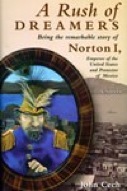 A Rush of Dreamers, being the Remarkable Story of Norton I, Emperor of the United States and Protector of Mexico. Marlowe, 1998.
A Rush of Dreamers, being the Remarkable Story of Norton I, Emperor of the United States and Protector of Mexico. Marlowe, 1998.
In San Francisco, a city famous for its eccentrics, the most celebrated of all was Joshua Norton who, in 1859, declared himself Emperor of the United States. One of the original ’49ers, Norton made and lost a fortune (and a good portion of his reason) during those rough and ready first years of the “instant” city that grew out of the sand dunes of Yerba Buena. Until his death in 1880, the Emperor presided over the public life of San Francisco. Dressed in his fabled uniform with its plumed hat, Norton made his daily rounds of the city; he attended its civic functions, inspected its progress, and issued proclamations, including one that called for the construction of a bridge between Oakland and San Francisco. Norton I became one of San Francisco’s most publicized attractions; and he remains a presence that still lingers around the Bay, where hotel suites and inns, a sightseeing boat, and even brands of coffee and cigars have been named in his honor.
John Cech’s novel recreates those dizzying days of the Gold Rush and its aftermath, when dreams of sudden riches could quickly become nightmares, and survival depended on the kindness of strangers and the persistence of the imagination. This book does, finally, what Mark Twain urged someone to do for his friend the Emperor over a century ago — “write him up.” Along the way, Cech tells the story not only of Emperor Norton but also of that Whitman-like catalogue of dreamers — merchants and mechanics, bandits and blacksmiths, clerks and clairvoyants, artists and inventors — who found themselves rushing for the promise of California.
(From the dust jacket)
Other screen and dramatic works include:
The Secret River, adapted from the children’s book by Marjorie Kinnan Rawlings. Set in the rural South during the Depression, this play focuses on Calpurnia, a courageous, creative African American girl and a poet in the making who discovers a mythic secret river and, with it, a source of sustenance for her community. The play contains numerous poems that Calpurnia invents, and these can be treated (as they were in one production of the play) as song lyrics. Thus, the play can be a kind of children’s opera or folk musical, with special effects, including life-size puppets.
From Inside a Swan’s Egg, an original, one-man play about the life of Hans Christian Andersen. The premise of the play is that Andersen has returned to his home town of Odense in order to receive an honorary award from the city. As he rummages through the belongs of his old house, he finds a trunk, and in it are puppets, toys and other cherished objects from his childhood, and as he unpacks each one, he describes how these simple, everyday things inspired some of his most famous work. This play was premiered at the World’s Fair in New Orleans in 1984, where it was a featured production of the ASSITEJ festival of theater for young people that was held in conjunction with the fair.
Can’t Slow Down, an original treatment for film about the remarkable and tragic life of Alfred Hair and the group of African American painters from Fort Pierce, Florida, who took up paint brushes rather than fruit picking buckets and carved a niche market for themselves painting scenes of rural and coastal Florida — which was then already vanishing along the high-gear development days of the Space Coast of Florida during the boom of NASA in the 1950s. This group of several dozen young men (and one young woman), painted fast and sold their paintings while they were still wet — scenes of sunsets and misty inlets, stormy beaches and spanish moss-bedecked trees — often for as little as $25. Alfred Hair was the charismatic leader of the group, who set the blistering pace for their production, and was the group’s boldest innovator. They often painted outdoors, with their upson board “canvases” nailed to the walls of their houses, with the whole neighborhood looking on.